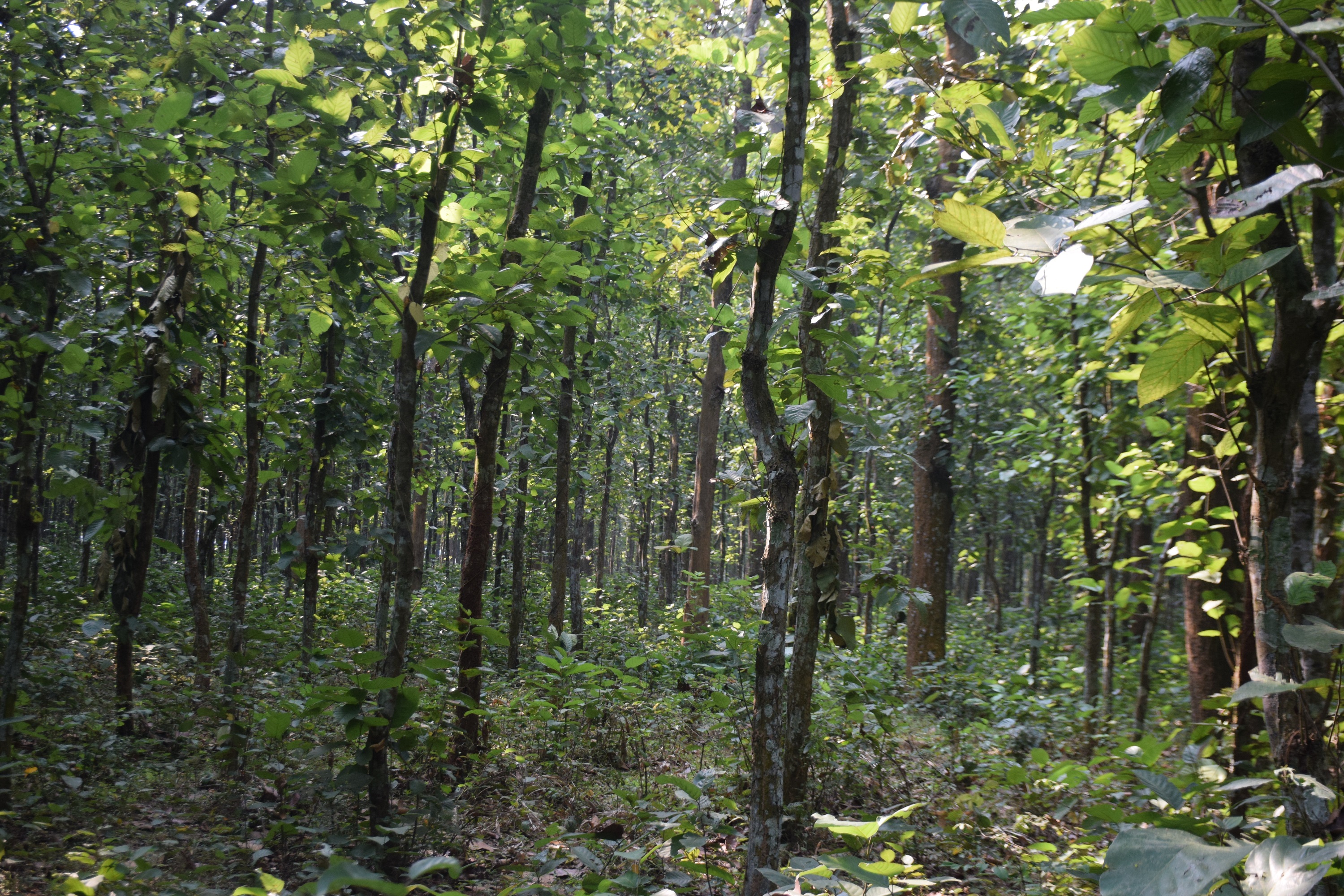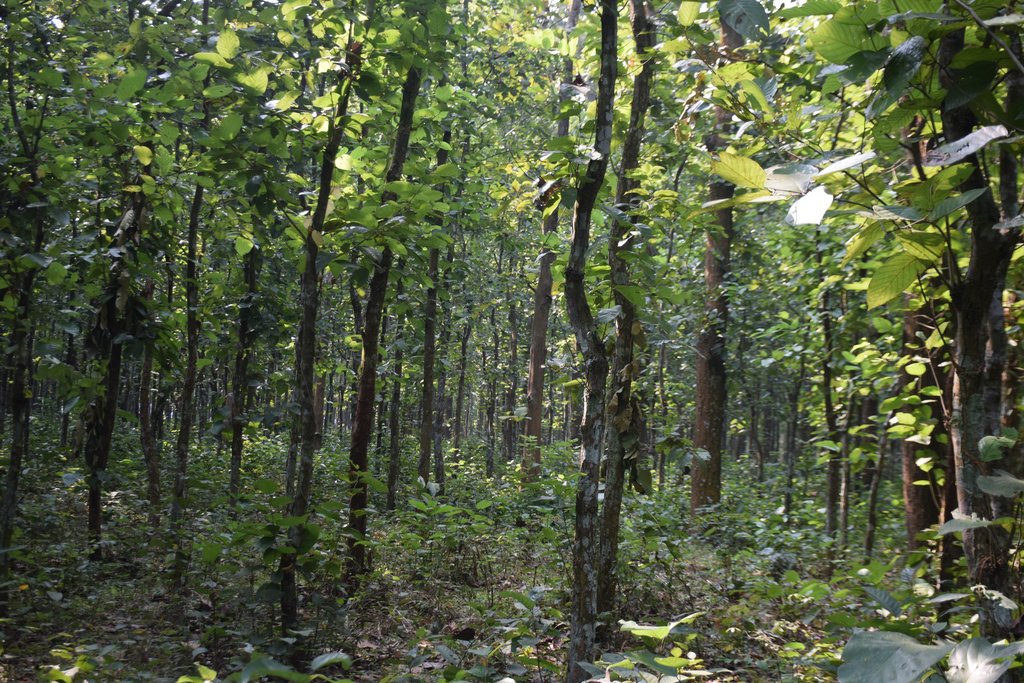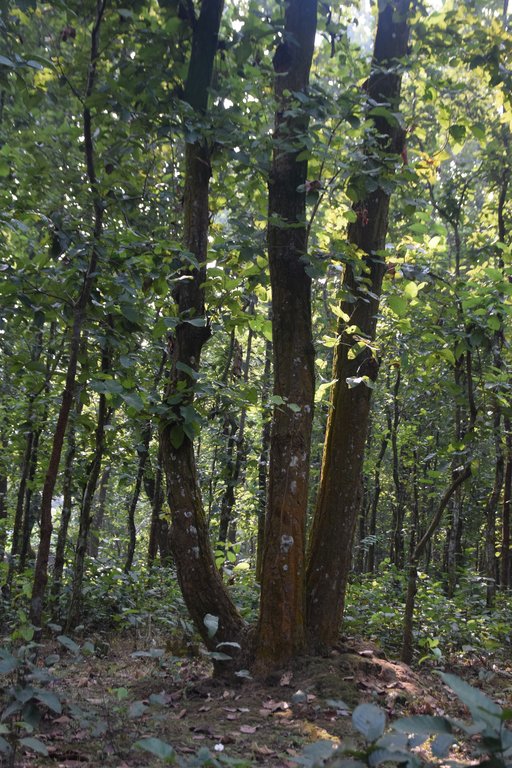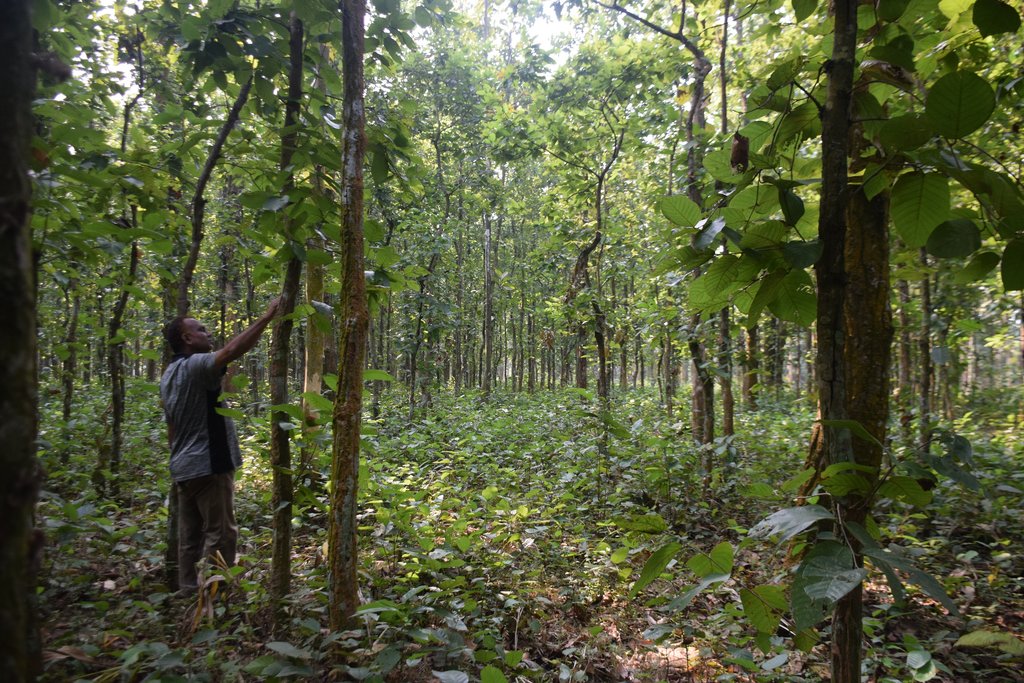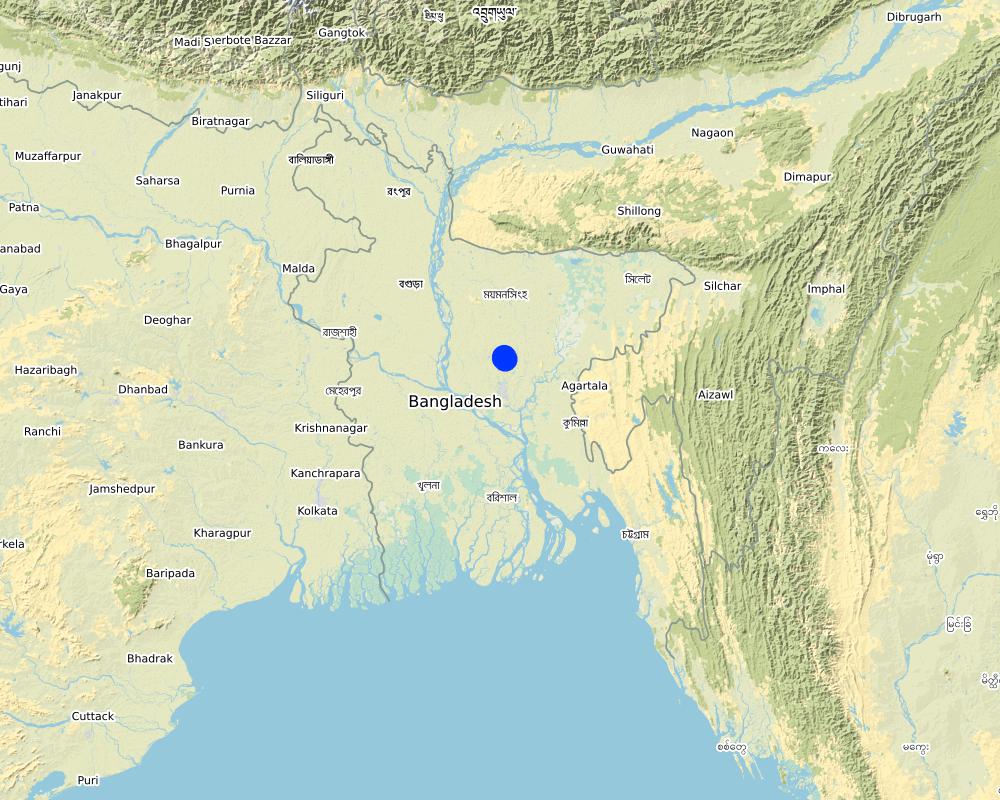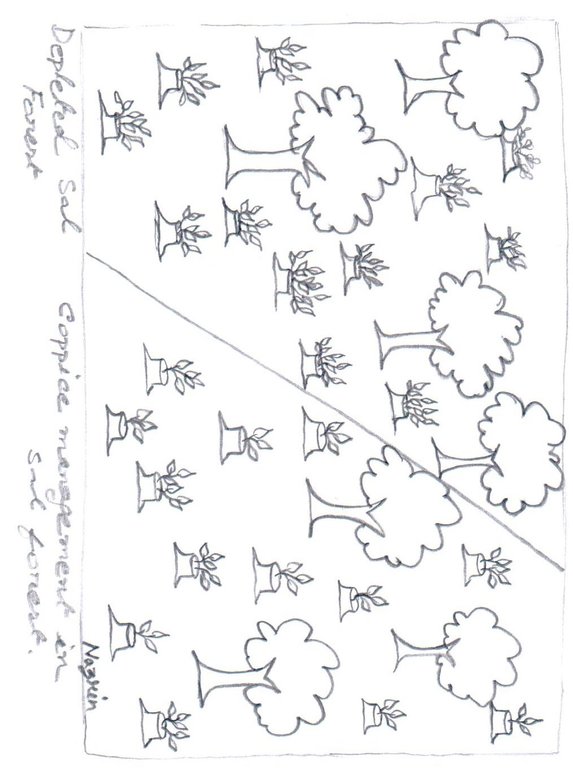Coppice management of Sal (Shorea robusta) forest [孟加拉国]
- 创建:
- 更新:
- 编制者: Fazlay Arafat
- 编辑者: –
- 审查者: Rima Mekdaschi Studer, Ursula Gaemperli
Sal bon bebosthapona
technologies_4830 - 孟加拉国
查看章节
全部展开 全部收起1. 一般信息
1.2 参与该技术评估和文件编制的资源人员和机构的联系方式
关键资源人
SLM专业人员:
Mohammed Nur
Bangladesh Forest Department
孟加拉国
土地使用者:
Abedin Md. Joynal
孟加拉国
土地使用者:
Rahman Md. Mojibur
孟加拉国
有助于对技术进行记录/评估的项目名称(如相关)
Decision Support for Mainstreaming and Scaling out Sustainable Land Management (GEF-FAO / DS-SLM)有助于对技术进行记录/评估的机构名称(如相关)
Bangladesh Forest Department (Bangladesh Forest Department) - 孟加拉国1.3 关于使用通过WOCAT记录的数据的条件
编制者和关键资源人员接受有关使用通过WOCAT记录数据的条件。:
是
1.4 所述技术的可持续性声明
这里所描述的技术在土地退化方面是否存在问题,导致无法被认为是一种可持续的土地管理技术?:
否
2. SLM技术的说明
2.1 技术简介
技术定义:
The coppice management of Sal (Shorea robusta) tree is a forest management practice to regain the natural forest resources in central and northern parts of Bangladesh.
2.2 技术的详细说明
说明:
Sal forests have a fairly wide and interrupted distribution in the drier central and northern parts of the country. These tropical moist deciduous forests are popularly known as Sal forest as the predominant species is Sal (Shorea robusta). The importance of Sal forests lies in the fact that these are the only natural forest resources of the central and northern parts of Bangladesh where the majority of the country’s population lives. Historically, the agrarian rural people around the forests have been heavily dependent on Sal forests for their livelihood. Until the beginning of the 20th century, Sal forests existed as a large continuous belt with rich biological resources but increasing pressure from population growth has been placed on them ever since. Most of the Sal forests have either become degraded in quality or reduces by conversion to agricultural land.
The Forest Department introduced coppice management with natural regeneration in Sal forest that have a rotation of 20-30 years to regain the forest structure and biomass. Coppicing is a traditional method of forest management, which exploits the capacity of tree species to put out new shoots from their stump or roots if cut down. Due to the fact that shoots perform better than seedlings, because they obtain water, nutrients and carbohydrates from a well-developed root system of the parent tree, they are more resilient to human disturbances that affect tree growth and survival. As new growth emerges after a number of years, the coppiced tree is harvested, and the cycle begins again. Therefore, coppicing is considered an efficient mechanism by which trees regain above-ground biomass immediately after disturbance.
The Gazipur Sal forest is located in lowland plain areas of the central parts of Bangladesh. The average temperature in Gazipur is 25.8 °C and the annual rainfall is 2036 mm. The area is densely populated with a population density of 2,505 per square km. The dominant land use is still agriculture, but industrialization rate is higher in the area as it is only 25km away from capital Dhaka. The Sal forest area is managed by Bangladesh Forest division. Co-management approach is introduced in some buffer areas for the coppice management of Shorea robusta with a profit-sharing ratio of 65:25 between forest department and community beneficiaries. The rest of 10% money allocated for further tree farming activities.
No new planting of Sal seedlings is necessary for this practice. In the first year a relatively poor-quality Sal stand of Gazipur site were selected where coppice regeneration took place from stumps. Then, the multiple shoots regenerated from the stump were singled to three best shoots per stump and the rest were harvested. These three shoots were maintained in the following years and new shoots were removed if there were any. In addition, regular weeding was needed to maintain the technology. Local community people engaged to the maintenance and surveillance activities through co-management modalities and they will get their profit share after harvesting of the mature stand.
Where the density of Sal stumps is between 200-400 stems/ha, coppice management potentially protects and promotes the growth of new Sal seedling and other natural species in open areas. The native species regeneration under coppice management helps protect biodiversity value in a cost-effective manner. Coppice Sal Forests have the capacity to regenerate a rich variety of Non-Timber Forest Products (NTFPs). The major NTFPs collected by the co-management beneficiaries include fuelwood, dry leaves for fuel, and medicinal plants. Apart from this, they also collect mushroom, tuber crops, wild fruits, cane, honey and resin from coppice forests. As the area is under permanently protected area the beneficiaries cannot harvest any timber from the stand.
As the artificial regeneration of Sal is difficult, the sustainable forest management can be ensured through coppice management of Sal. In Gazipur, the depleted Sal forest are now slowly regaining its health and habitats for wildlife are improving as well. These forests, which historically were seen as timber sources, are now managed for multiple products through coppice management. The forest now supports alternate income for community people and also playing important role for ecological balance of this region.
2.3 技术照片
2.5 已应用该技术的、本评估所涵盖的国家/地区/地点
国家:
孟加拉国
区域/州/省:
Dhaka division
有关地点的进一步说明:
Gazipur
具体说明该技术的分布:
- 均匀地分布在一个区域
如果不知道精确的区域,请注明大致覆盖的区域:
- 10-100 平方千米
技术现场是否位于永久保护区?:
是
如果是,请具体说明:
The Gazipur Sal forest is located in a permanent protected area where local communities cannot collect any timber other than fuel wood and NTFP
Map
×2.6 实施日期
如果不知道确切的年份,请说明大概的日期:
- 10-50年前
2.7 技术介绍
详细说明该技术是如何引入的:
- 作为传统系统的一部分(> 50 年)
3. SLM技术的分类
3.1 该技术的主要目的
- 改良生产
- 减少、预防、恢复土地退化
- 保护生态系统
- 创造有益的经济影响
- 创造有益的社会影响
3.2 应用该技术的当前土地利用类型
同一土地单元内混合使用的土地::
否

森林/林地
- (半天然)天然森林/林地
(半天然)天然森林/林地:具体说明管理类型:
- 清除枯木/剪枝
(半)天然林类型:
- 热带潮湿落叶林天然植被
- Shorea robusta; Terminalia bellirica; Phyllanthus emblica; Albizia saman
以上的树木是落叶树还是常绿树?:
- 混合落叶或常绿
产品和服务:
- 木材
- 薪材
- 水果和坚果
- 其它森林产品
- 自然保持/保护
- 娱乐/旅游
3.3 由于技术的实施,土地使用是否发生了变化?
由于技术的实施,土地使用是否发生了变化?:
- 否(继续问题3.4)
注释:
The original Sal forest stand faced rapid reduction through over-exploitation, deforestation, excessive leaf-litter collection, encroachment, indiscriminate collection of specific economically important plant species (i.e medicinal, fodder etc), and other form of human interference. This was degraded forest with some scatter trees.
3.4 供水
该技术所应用土地的供水:
- 雨养
3.5 该技术所属的SLM组
- 天然和半天然森林管理
- 森林种植管理
- 改良的地面/植被覆盖
3.6 包含该技术的可持续土地管理措施

植物措施
- V1:乔木和灌木覆盖层

管理措施
- M2:改变管理/强度级别
3.7 该技术强调的主要土地退化类型

土壤水蚀
- Wt:表土流失/地表侵蚀

土壤风蚀
- Et:表土流失

生物性退化
- Bc:植被覆盖的减少
- Bh:栖息地丧失
- Bq:数量/生物量减少
- Bs:质量和物种组成/多样性的下降
- Bl:土壤寿命损失
3.8 防止、减少或恢复土地退化
具体数量名该技术与土地退化有关的目标:
- 减少土地退化
4. 技术规范、实施活动、投入和成本
4.1 该技术的技术图纸
技术规范(与技术图纸相关):
The left hand of the picture represents a depleted Sal forest where only few trees remain and multiple shoots regenerated from the stumps of chopped down Sal trees. The right hand of the picture shows the coppice management in the depleted forest stand. From the regenerated multiple shoots of only one to three best shoots per stump are allowed to grow and other shoots removed. These three shoots were maintained in the following years and new shoots were removed if there were any.
作者:
Nazrin Sultana
日期:
20/05/2019
4.2 有关投入和成本计算的一般信息
具体说明成本和投入是如何计算的:
- 每个技术区域
注明尺寸和面积单位:
1 ha
如果使用本地面积单位,注明转换系数为1公顷(例如1公顷=2.47英亩):1公顷=:
2.47 acres
其它/国家货币(具体说明):
BDT
如相关,注明美元与当地货币的汇率(例如1美元=79.9巴西雷亚尔):1美元=:
84.0
注明雇用劳工的每日平均工资成本:
500 BDT
4.3 技术建立活动
| 活动 | 时间(季度) | |
|---|---|---|
| 1. | Site preparation (prepare plantation site map with GPS, jungle cutting, debris collection) | June-July |
| 2. | Thinning (removal of unwanted shoots from stumps) | June-July |
| 3. | Application of fertilizer (compost) | July |
4.4 技术建立所需要的费用和投入
| 对投入进行具体说明 | 单位 | 数量 | 单位成本 | 每项投入的总成本 | 土地使用者承担的成本% | |
|---|---|---|---|---|---|---|
| 劳动力 | Site preparation (prepare plantation site map with GPS, jungle cutting, debris collection) | person-days | 5.0 | 500.0 | 2500.0 | 100.0 |
| 劳动力 | Thinning (removal of unwanted shoots from stumps) | person-days | 12.0 | 500.0 | 6000.0 | 100.0 |
| 劳动力 | Application of fertilizer | person-days | 5.0 | 500.0 | 2500.0 | 100.0 |
| 设备 | Spade, saw, bucket, knife, etc. | lump sum | 1.0 | 2000.0 | 2000.0 | 100.0 |
| 肥料和杀菌剂 | Compost fertilizer | kg | 2000.0 | 4.0 | 8000.0 | 100.0 |
| 技术建立所需总成本 | 21000.0 | |||||
| 技术建立总成本,美元 | 250.0 | |||||
注释:
Bangladesh Forest Department is the land owner and bear the cost of this practice
4.5 维护/经常性活动
| 活动 | 时间/频率 | |
|---|---|---|
| 1. | 1st year weeding | 3 times |
| 2. | 2nd year weeding | 3 times |
| 3. | 3rd year weeding | 2 times |
| 4. | 4th year weeding | 1 time |
4.6 维护/经常性活动所需要的费用和投入(每年)
| 对投入进行具体说明 | 单位 | 数量 | 单位成本 | 每项投入的总成本 | 土地使用者承担的成本% | |
|---|---|---|---|---|---|---|
| 劳动力 | 1st year weeding | person-days | 12.0 | 500.0 | 6000.0 | 100.0 |
| 劳动力 | 2nd year weeding | person-days | 12.0 | 500.0 | 6000.0 | 100.0 |
| 劳动力 | 3rd year weeding | person-days | 8.0 | 500.0 | 4000.0 | 100.0 |
| 劳动力 | 4th year weeding | person-days | 4.0 | 500.0 | 2000.0 | 100.0 |
| 设备 | Spade, saw, bucket, knife, etc. | Lump-sum | 1.0 | 2000.0 | 2000.0 | 100.0 |
| 技术维护所需总成本 | 20000.0 | |||||
| 技术维护总成本,美元 | 238.1 | |||||
4.7 影响成本的最重要因素
描述影响成本的最决定性因素:
Labor cost
5. 自然和人文环境
5.1 气候
年降雨量
- < 250毫米
- 251-500毫米
- 501-750毫米
- 751-1,000毫米
- 1,001-1,500毫米
- 1,501-2,000毫米
- 2,001-3,000毫米
- 3,001-4,000毫米
- > 4,000毫米
农业气候带
- 半湿润
5.2 地形
平均坡度:
- 水平(0-2%)
- 缓降(3-5%)
- 平缓(6-10%)
- 滚坡(11-15%)
- 崎岖(16-30%)
- 陡峭(31-60%)
- 非常陡峭(>60%)
地形:
- 高原/平原
- 山脊
- 山坡
- 山地斜坡
- 麓坡
- 谷底
垂直分布带:
- 0-100 m a.s.l.
- 101-500 m a.s.l.
- 501-1,000 m a.s.l.
- 1,001-1,500 m a.s.l.
- 1,501-2,000 m a.s.l.
- 2,001-2,500 m a.s.l.
- 2,501-3,000 m a.s.l.
- 3,001-4,000 m a.s.l.
- > 4,000 m a.s.l.
说明该技术是否专门应用于:
- 不相关
5.3 土壤
平均土层深度:
- 非常浅(0-20厘米)
- 浅(21-50厘米)
- 中等深度(51-80厘米)
- 深(81-120厘米)
- 非常深(> 120厘米)
土壤质地(表土):
- 细粒/重质(粘土)
土壤质地(地表以下> 20厘米):
- 细粒/重质(粘土)
表土有机质:
- 高(>3%)
5.4 水资源可用性和质量
地下水位表:
5-50米
地表水的可用性:
中等
水质(未处理):
仅供农业使用(灌溉)
水质请参考::
地表水
水的盐度有问题吗?:
否
该区域正在发生洪水吗?:
否
5.5 生物多样性
物种多样性:
- 中等
栖息地多样性:
- 中等
5.6 应用该技术的土地使用者的特征
定栖或游牧:
- 定栖的
生产系统的市场定位:
- 混合(生计/商业)
非农收入:
- 收入的10-50%
相对财富水平:
- 平均水平
个人或集体:
- 员工(公司、政府)
机械化水平:
- 手工作业
性别:
- 女人
- 男人
土地使用者的年龄:
- 青年人
- 中年人
- 老年人
5.7 应用该技术的土地使用者使用的平均土地面积
- < 0.5 公顷
- 0.5-1 公顷
- 1-2 公顷
- 2-5公顷
- 5-15公顷
- 15-50公顷
- 50-100公顷
- 100-500公顷
- 500-1,000公顷
- 1,000-10,000公顷
- > 10,000公顷
这被认为是小规模、中规模还是大规模的(参照当地实际情况)?:
- 中等规模的
5.8 土地所有权、土地使用权和水使用权
土地所有权:
- 州
土地使用权:
- 社区(有组织)
用水权:
- 自由进入(无组织)
土地使用权是否基于传统的法律制度?:
否
具体说明:
Participatory forest management in coppice Sal forest with local commuities
5.9 进入服务和基础设施的通道
健康:
- 贫瘠
- 适度的
- 好
教育:
- 贫瘠
- 适度的
- 好
技术援助:
- 贫瘠
- 适度的
- 好
就业(例如非农):
- 贫瘠
- 适度的
- 好
市场:
- 贫瘠
- 适度的
- 好
能源:
- 贫瘠
- 适度的
- 好
道路和交通:
- 贫瘠
- 适度的
- 好
饮用水和卫生设施:
- 贫瘠
- 适度的
- 好
金融服务:
- 贫瘠
- 适度的
- 好
6. 影响和结论性说明
6.1 该技术的现场影响
社会经济效应
生产
木材生产
森林/林地质量
非木材林业生产
生产故障风险
产品多样性
注释/具体说明:
Some agroforestry products also derived from the practice of local communities
收入和成本
收入来源的多样性
社会文化影响
土地使用权/用水权
注释/具体说明:
re-establishment of Sal forest through coppice management with involving local community allowed them to collect NTFP from the forest
文化机会
娱乐机会
注释/具体说明:
Ecotourism has benn promoted in the area
社区机构
注释/具体说明:
Through co-management of Sal forest the local community institutions strengthened
SLM/土地退化知识
注释/具体说明:
The scattered degraded forest is now managed in a sustainable manner
冲突缓解
注释/具体说明:
Conflict on forest land use has been reduced due to co-management
社会经济弱势群体的情况
注释/具体说明:
the extreme poor people who were depended on forest now are member of the co-management group under the profit sharing approach
生态影响
土壤
土壤水分
土壤覆盖层
土壤流失
土壤堆积
土壤压实
养分循环/补给
土壤有机物/地下C
生物多样性:植被、动物
植被覆盖
生物量/地上C
植物多样性
有益物种
栖息地多样性
减少气候和灾害风险
碳和温室气体的排放
风速
微气候
6.2 该技术的场外影响已经显现
水资源可用性
注释/具体说明:
groundwater aquifer recharges due to presence of forest canopy cover
缓冲/过滤能力
风力搬运沉积物
温室气体的影响
6.3 技术对渐变气候以及与气候相关的极端情况/灾害的暴露和敏感性(土地使用者认为的极端情况/灾害)
渐变气候
渐变气候
| 季节 | 增加或减少 | 该技术是如何应对的? | |
|---|---|---|---|
| 年温度 | 增加 | 好 | |
| 季节性温度 | 夏季 | 增加 | 好 |
| 年降雨量 | 减少 | 好 | |
| 季雨量 | 湿季/雨季 | 增加 | 好 |
气候有关的极端情况(灾害)
气象灾害
| 该技术是如何应对的? | |
|---|---|
| 局地暴雨 | 好 |
| 局地雷暴 | 好 |
气候灾害
| 该技术是如何应对的? | |
|---|---|
| 干旱 | 适度 |
6.4 成本效益分析
技术收益与技术建立成本相比如何(从土地使用者的角度看)?
短期回报:
轻度消极
长期回报:
非常积极
技术收益与技术维护成本/经常性成本相比如何(从土地使用者的角度看)?
短期回报:
轻度消极
长期回报:
非常积极
6.5 技术采用
- > 50%
在所有采用这项技术的人当中,有多少人是自发的,即未获得任何物质奖励/付款?:
- 91-100%
注释:
Forest department adopted the technology and replicate it in other Sal forest area with co-management approach
6.6 适应
最近是否对该技术进行了修改以适应不断变化的条件?:
否
6.7 该技术的优点/长处/机会
| 土地使用者眼中的长处/优势/机会 |
|---|
| Establishment and maintenance costs arelow. |
| Artificial regeneration of Sal is difficult. Through coppice management forest coverage can be ensured for long period. |
| The population of the community can cover their fuel needs from the Sal forests. |
| 编制者或其他关键资源人员认为的长处/优势/机会 |
|---|
| Increases the soil fertility of the degraded land through nutrient cycle. |
| Biodiversity conservation through habitat improvement. |
| Increase of carbon sequestration. |
6.8 技术的弱点/缺点/风险及其克服方法
| 土地使用者认为的弱点/缺点/风险 | 如何克服它们? |
|---|---|
| Protection from illicit felling of Sal is difficult. | Community people need to be engage in patrolling |
| Occurrence of fire in dry seasons hampered Sal coppice stand |
| 编制者或其他关键资源人员认为的弱点/缺点/风险 | 如何克服它们? |
|---|---|
| Timber yield from coppice stand of Sal is inferior in comparison with original stand of Sal. | Vacancy filling can be done with high value timber species |
7. 参考和链接
7.1 信息的方法/来源
- 实地考察、实地调查
Number of informants: 5 persons
- 与土地使用者的访谈
Number of informants: 4 persons
- 与SLM专业人员/专家的访谈
Number of informants: 2 persons
- 根据报告和其他现有文档进行编译
Number of scientific articles: 3
(现场)数据是什么时候汇编的?:
20/11/2018
7.2 参考可用出版物
标题、作者、年份、ISBN:
Islam KK, Sato N, 2012. Deforestation, land conversion and illegal logging in Bangladesh: the case of the Sal (Shorea robusta) forests. iForest 5: 171-178 [online 2012-06-25]
可以从哪里获得?成本如何?
http://www.sisef.it/iforest/contents? id=ifor0578-005
标题、作者、年份、ISBN:
Hossain, M.K. 2015. Silviculture of Plantaion Trees of Bangladesh, ISBN:978-984-33-9767-6
可以从哪里获得?成本如何?
Arannayk Foundation, Dhaka, Bangladesh. US$ 15
7.3 链接到网络上的相关信息
标题/说明:
Joint Forest Management and Adaptation of Sal (Shorea robusta) and Its Flexibility in Wide Range of Ecological factors in Forest Gardens
URL:
http://ajast.net/data/uploads/5022.pdf
7.4 一般注释
The questionnaire covers all the aspect of the practice
链接和模块
全部展开 全部收起链接
无链接
模块
无模块


